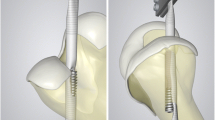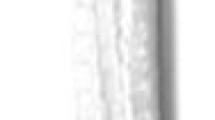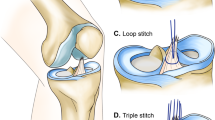Summary
The mechanical properties, including maximum load, elongation, and axial rigidity, of the biodegradable poly-l-lactic acid (PLLA) ligament augmentation device were investigated, 6, 12, 24, and 48 weeks after experimental anterior cruciate ligament (ACL) repair in 32 sheep. In 16 sheep the cut ACL was removed and reconstructed with the fascia lata augmented with a braided PLLA implant 3.2 mm in diameter. In 16 sheep the ACL was cut from its midportion, sutured, and then augmented with a PLLA implant. The contralateral knee served as a control. At 6 weeks the maximum loads of the reconstructed ACL in the fascia lata-PLLA and primary suture-PLLA groups were 9% and 6%, respectively, of the contralateral ACL, but they increased with time and at 48 weeks were 21% and 12%, respectively, of the control. In the fascia lata-PLLA group the increase in maximum load was evident (P < 0.05) during the follow-up period. During the first 12 weeks the axial rigidity (expressing the elasticity of the reconstruction) was poor, especially in the high-stress region corresponding to the tensile load close to the maximum load. Thereafter the axial rigidity increased, being 48% of the control in the fascia lata-PLLA group and 29% in the primary suture-PLLA group at 48 weeks. In the low-stress region between 10 N and 100 N the increase in axial rigidity in the fascia lata-PLLA group was apparent (P < 0.05) throughout the follow-up, with values of 72% of the control in the fascia lata-PLLA and 47% in the primary suture-PLLA group at 48 weeks. Fascia lata augmented with PLLA seemed to yield a better result than primary suture augmented with PLLA, although no statistically significant difference was found. Despite modest mechanical properties in the early postoperative period, good functional recovery with minor radiographic changes and acceptable mechanical properties were achieved by the end of the 1-year follow-up period.
Similar content being viewed by others
References
Butler DL, Grood ES, Noyes FR, Olmstead ML, Hohn B, Arnoczky SP, Siegel MG (1989) Mechanical properties of primate vascularized vs. nonvascularized patellar tendon grafts: changes over time. J Orthop Res 7:68–79
Holden JP, Grood ES, Butler DL, Noyes FR, Mendenhall HV, Van Kampen CL, Neidich RL (1988) Biomechanics of fascia lata ligament replacements: early postoperative changes in the goat. J Orthop Res 6:639–647
Hollinger JO, Battistone GC (1986) Biodegradable bone repair materials: synthetic polymers and ceramics. Clin Orthop 207:290–305
Laitinen O, Toivonen T, Vasenius J, Törmälä P, Alitalo I, Vainionpää S (1993) Tissue response to braided poly-l-lactide implant in experimental reconstruction of anterior cruciate ligament. J Mater Sci Mater Med (in press)
Laitinen O, Törmälä P, Taurio R, Skutnabb K, Saarelainen K, Iivonen T, Vainionpää S (1992) Mechanical properties of biodegradable ligament augmentation device of poly(l-lactide) in vitro and in vivo. Biomaterials 13:1012–1016
McPherson GK, Mendenhall HV, Gibbons DF, Plenk H, Rottmann W, Sanford JB, Kennedy JC, Roth JH (1985) Experimental mechanical and histologic evaluation of the Kennedy ligament augmentation device. Clin Orthop 196:186–195
Nakamura T, Hitomi S, Watanabe S, Shimizu Y, Jamshidi K, Hyon S-H, Ikada Y (1989) Bioabsoprtion of polylactides with different molecular properties. J Biomed Mater Res 23:1115–1130
Noyes FR, Keller CS, Grood ES, Butler DL (1984) Advances in the understanding of knee ligament injury, repair, and rehabilitation. Med Sci Sports Exerc 16:427–443
Oster DM, Grood ES, Feder SM, Butler DL, Levy MS (1992) Primary and coupled motions in the intact and the ACL-deficient knee: an in vitro study in the goat model. J Orthop Res 10:476–484
Schepsis AA, Greenleaf J (1990) Prosthetic materials for anterior cruciate ligament reconstruction. Orthop Rev 19:984–991
Author information
Authors and Affiliations
Rights and permissions
About this article
Cite this article
Laitinen, O., Pohjonen, T., Törmälä, P. et al. Mechanical properties of biodegradable poly-l-lactide ligament augmentation device in experimental anterior cruciate ligament reconstruction. Arch Orthop Trauma Surg 112, 270–274 (1993). https://doi.org/10.1007/BF00452963
Received:
Issue Date:
DOI: https://doi.org/10.1007/BF00452963




